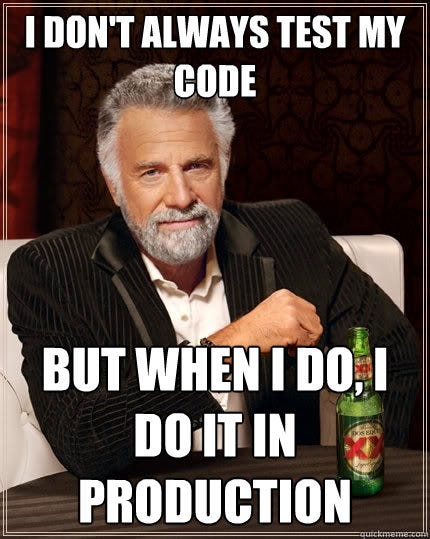E3.1: Bring your Project to Production: Where 'Works on My Machine' Meets Reality
Production experience is often missing from scholars, juniors, and sometimes from medior Data Scientists. How do you get your model out of a Jupyter notebook? Or your project from a local host?
Deploying to production is a crucial step that bridges the gap between theoretical research/side projects and real-world applications. Many data scientists and analysts, especially those transitioning from academia or early in their careers, often find this process challenging. What most of them are missing, which is generally not taught in university, is basic SOFTWARE DEVELOPMENT SKILLS. This guide goes over important aspects of the production deployment process, covering essential practices and considerations to ensure a smooth transition from development to production.
@imjosef
1. Understanding the Production Environment
Before deploying a system, it’s essential to understand the production environment where the system will operate. Key considerations include:
Scalability Requirements: Assess if the system needs to handle large volumes of data or concurrent requests.
For example, for an e-commerce platform predicting user behaviour, the model may need to scale to handle thousands of predictions per second, especially during peak shopping periods. This requires robust infrastructure and possibly load balancing to distribute the computational load.
Integration Points: Identify how the system will integrate with existing systems and data sources. As an example, deploying a credit risk model often involves logistic regression.
Big financial organisations generally make use of a SQL database (provided by those lovely SAP guys). Once the model is finalised, the model’s (transformed) weights, coefficients, and buckets must be translated into SQL code to be shared with the SQL team. Pretty manual unfortunately.Performance Constraints: Ensure the model meets performance benchmarks, such as response time and throughput.
For a real-time fraud detection system, the model needs to process transactions within milliseconds to prevent fraudulent activities. This requires optimising the model’s inference time and ensuring the underlying infrastructure can support such low-latency requirements without compromising accuracy.
If there is no production environment yet, e.g. for your side project, choose the cloud of your preference. If not familiar with any cloud environment, make sure to learn one. If no appetite to learn or if it’s a simple deployment, stick with Heroku.
don’t do this
2. Code, Versioning, and CI/CD Pipelines
Effective version control and automated deployment processes are critical for maintaining reproducibility, collaboration, and efficiency in bringing systems and models to production.
Version Control Systems (VCS): Use systems like Git to track changes in code and data. This ensures that every modification is documented, allowing teams to collaborate seamlessly and maintain a history of changes. As a tip, from now on never use the UI anymore. Teach yourself to work with the terminal.
Model Versioning: Implement a strategy to version models, enabling rollback to previous versions if needed. This is crucial for tracing model performance over time and ensuring that any updates or changes can be easily managed and reverted if necessary. If you don’t use a CI/CD tool, make sure that your deployed version is always the same as the most recent version on your VCS.
CI/CD Tools: Use tools like Jenkins, GitLab CI, or CircleCI to automate the testing and deployment processes. CI/CD pipelines help in maintaining code quality and facilitate continuous integration and delivery. Not really necessary for a small/moderate size project yet using them will save you time.
Pipeline Stages: Include stages such as build, test, and deploy in your CI/CD pipeline. Automating these stages reduces manual errors and enhances efficiency, ensuring that the code and models are consistently tested and deployed in a reliable manner.
Build Stage: Compile and prepare the code for deployment.
Test Stage: Run automated tests to validate code and model performance.
Deploy Stage: Deploy the code and models to the production environment.
3. Containerisation and Orchestration
Containerisation simplifies deployment and ensures consistency across environments:
Docker: Containerise the model and its dependencies using Docker. I highly recommend you familiarise yourself with using Docker.
Kubernetes: Use Kubernetes for orchestrating and managing containerised applications at scale. For small projects, please don’t bother. Check this blog is you are in doubt.
5. Monitoring and Logging
Continuous monitoring and logging are essential for maintaining model performance:
Logging Practices: Implement structured logging to capture relevant information for debugging and analysis. For Python, I’d recommend setting up a basic logger and replace all print statements with it:
import logging
logging.basicConfig(level=logging.INFO)
logger = logging.getLogger(__name__) # It's good practice to use __name__ to get the correct loggerMost monitoring systems will recognise this type of logging perfectly. You can set different levels as well (warning/bug). Pretty sweet. In addition, make sure to catch as much errors as possible within your code. Leverage Try Except statements as much as you can.
Monitoring Tools: Mostly depends on your choice of cloud. You can leverage stand alone tools like Prometheus, Grafana, or ELK stack for monitoring.
Alerting: Set up alerts to notify the team of any anomalies or performance issues. Your cloud provider generally has some options in place.
6. Data and Model Governance
Governance ensures compliance and ethical use of data and models:
Data Privacy: Adhere to data privacy regulations like GDPR/AVG (Dutch).
Audit Trails: Maintain detailed records of data processing and model changes.
7. Security Considerations
Securing the model and data is important:
Authentication and Authorization: Implement robust authentication and authorization mechanisms.
Data Encryption: Encrypt data in transit and at rest.
Vulnerability Scanning: Regularly scan for vulnerabilities in code and dependencies.
8. Performance Optimisation
Optimize the model and infrastructure to meet performance requirements:
Profiling and Tuning: Profile the software system to identify bottlenecks and optimize performance. Use profiling tools to analyse CPU, memory, and I/O usage, and make necessary adjustments to improve efficiency and speed.
Hardware Acceleration: Leverage hardware accelerators like TPUs for inference, if necessary. Consider using specialised hardware to enhance processing power and handle intensive computational tasks more efficiently.
9. Documentation and Knowledge Sharing
Not the nicest task but comprehensive documentation facilitates maintenance and collaboration:
API Documentation: Document APIs using tools like Swagger or Postman.
User Guides: Create detailed guides for users and stakeholders.
Knowledge Sharing: Encourage knowledge sharing through workshops, seminars, or wikis.
Fortunately, you can leverage your gen AI counterparts to do at least 80 pct of the work for you. What a time to be alive.
Conclusion
Bringing software systems, including data science models, to production involves more than just development. It requires careful planning, robust infrastructure, and continuous monitoring to ensure they deliver value in real-world settings. By following these best practices, developers and data scientists can bridge the gap between development and production, ensuring their systems are scalable, reliable, and secure.
Call to Action
Are you ready to take your software systems and models to production? Start by assessing your current workflow against these best practices and identify areas for improvement. Yet the most important thing here is to get your hands dirty as quickly as possible. Deploy something and get experience. Embrace automation, continuous monitoring, and robust governance to ensure your projects are production-ready and deliver sustained value to you and/or your organisation.
E3.2: Bringing Agentic to Life.
In the next edition, I’ll demonstrate how to deploy Agentic - a Telegram bot that scrapes Reddit and post its findings to Twitter - and use a Cron job to let it run once per day. We’re using Microsoft Azure for this. Stay tuned and thanks for reading.
Michiel




